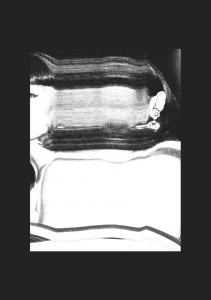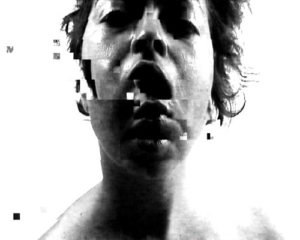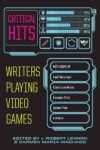 Sometimes, I wake up in the morning and I feel pretty for no real reason and I swear, after that my entire day is made. Nothing can do me wrong, as long as I feel at least a little bit beautiful, whatever that means.
Sometimes, I wake up in the morning and I feel pretty for no real reason and I swear, after that my entire day is made. Nothing can do me wrong, as long as I feel at least a little bit beautiful, whatever that means.
Some weeks ago I encountered two very different discussions of aesthetic ideals: Zadie Smith’s On Beauty, and glitch art.
On Beauty is interesting in that Smith knows exactly what she’s doing, and she knows exactly what beauty — and perhaps the definition of it is hazy, but its effects certain — can do:
“And all the time, while he spoke, and she tried, bewilderedly, to listen, his face was doing its silent voodoo on her, just as it seemed to work on everybody passing by him in this archway. Zora could clearly see people stealing a look, and lingering, not wanting to release the imprint of Carl from their retinas, especially if it was only to be replaced by something as mundane as a tree or the library or two kids playing cards in the yard. What a thing he was to look at!”
Maybe there’s something caustic about this particular kind of beauty. This brash, in your face, b-e-a-u-t-i-f-u-l. Smith knows what beauty can do, what it means, how dumb and tongue-tied and fuzzy-headed we all get in the face of something or -one we just can’t stop looking at. Yet that “silent voodoo,” Carl’s “well-madeness as a human being” is not the crux of aesthetic desire; it is not perfection, not in this novel. On Beauty has no argument, no neat nexus: we see the characters rise and fall, gloat about triumphs and hit astounding lows. They simply exist. What is woven throughout the novel are varying kinds and depths of beauty. On Beauty is true to its title: it is a discussion, not a resolution. And in this discussion beauty is found to contain multitudes.
The first time I saw glitch art, I loved it immediately. It made sense to me: the stretch, the warp, the smeared pixels, the subversion of what I have been coded to think is perfect and beautiful. Glitch art has been around for some years now, but it’s been recently making its way into more popular forms of visual culture — graphic design, for example. The appeal of glitch lies in its key component: the flaw. It’s messy, and it’s complex. It comes about in different forms — switching pixels, corrupting data, but the principle is the same: A subversion of what’s conventional and an aestheticization of flaws. Glitch exists in randomness. And a glitched specimen is far more interesting than a “perfect” one.
We’re taught how to see from a very young age and we learn what’s supposed to matter while we’re looking. But nothing is objective, regarding beauty — forget what anyone’s ever told you about nature’s secrets o r the golden ratio or divine proportions because someone’s apathy will be someone’s excess and the only thing consistent about beauty is how homogenized the media representations are that exist. I shouldn’t have to tell you this, but: mainstream media all too often likes its beauty thin, white, and standardized.
r the golden ratio or divine proportions because someone’s apathy will be someone’s excess and the only thing consistent about beauty is how homogenized the media representations are that exist. I shouldn’t have to tell you this, but: mainstream media all too often likes its beauty thin, white, and standardized.
And like a breath of fresh air, On Beauty’s beautiful characters break out of that homogeneity. Most of them are not white. They are black; they are different degrees and variations and complexities of blackness; they are multifaceted. They deviate from the norm of “beauty” as it’s so often written about and presented.
These representations of beauty matter because we are constantly surrounded by all these standardized ideals of beauty, and the answer to “what is beautiful?” becomes so narrow young people don’t even know how to fit into it.
It’s important to present ideas and kinds of beauty that don’t fit into the monolith, and also represent characters as flawed, as complex, as human. Because people of color are allowed to fuck up too and they’re allowed to be beautiful while they do it and they’re allowed to also be more than fuck ups and we are forever in need of these stories, of these reminders. We are allowed to be human and we are allowed to be beautiful and we are allowed to make mistakes.
Glitch subverts the dominant idea of beauty by letting us see variations and complexities. It’s another, better way of seeing beauty; it lets us examine multiplicities — all the things that beautiful can be. It’s addictive because every piece of glitch is a little bit different. Glitch highlights the things that one can’t control, the randomness of something made and made manifest; it is a celebration of all the facts and features that make one thing different from the rest.
I liked On Beauty so much because all of its characters are flawed, and they are allowed to be such. They are all a little bit imperfect in one way or another, but they are beautiful — Kiki’s radiance, Carl’s athletic perfection — but also in their earnestness as characters. They have desires, noble or ig-, but they are honest. As the novel is told from multiple perspectives, so do we get to experience the entirety of each character: their wants and their goals. Some go backward and some go forward and some fall into the wrong trajectories and make horrendous decisions but honestly, that’s how life works.
We like glitch because it’s a little bit messed up, just like us. It’s taking the parts that we might consider mistakes or flaws and illuminating them and saying, hey, this is beautiful. And it is beautiful, and it’s interesting. It breaks from the monolith. It opens our eyes to more than just mass expectations of beauty.
On Beauty works because Smith is unrelenting in the pain her characters experience and inflict. They aren’t perfect. Nothing about them is perfect but they are allowed to be beautiful. It is celebrated. It shows us a kind of beauty — whatever that elusive concept might be, whatever it can be — that is flawed and honest and diverse.
At this point in writing this, I’m not even sure what beauty even means anymore; I’ve written the damn word so many times. I woke up late this morning and realized I’d forgotten to take off my eyeliner from the day before. It was smeared and messy, as if I’d gotten into a fight. But I kind of liked it. I looked at myself in the mirror and I thought, “All right.”
This post may contain affiliate links.







